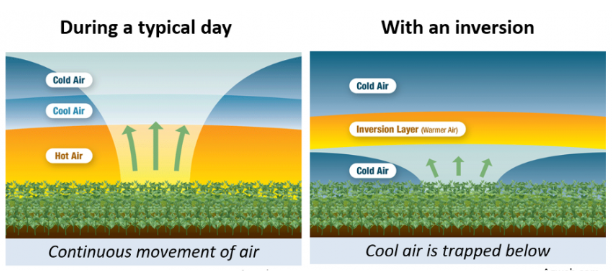Normal Lapse Rate and Temperature Inversion Under typical conditions, as we ascend through the troposphere, the temperature usually decreases with an increase in altitude at a rate of 1 degree for every 165 meters. This phenomenon is known as the normal lapse rate. However, there are occasions when this pattern gets reversed, and instead of decreasing, the temperature starts increasing with height. This occurrence is referred to as temperature inversion.
Average Lapse Rate and its Impact The environmental lapse rate, which varies from place to place and over time, particularly in the lowest few hundred meters of the troposphere, has an average rate of temperature change of about 6.5°C per 1000 meters (3.6°F per 1000 feet). This is called the average lapse rate or average vertical temperature gradient within the troposphere. In practical terms, if a thermometer measures the temperature 1000 meters above a previous measurement, the reading will be, on average, 6.5°C cooler. Conversely, a second measurement made 1000 meters lower than the first will yield a temperature approximately 6.5°C warmer.
Temperature Inversion or Thermal Inversion Typically, as we ascend through the troposphere from the surface, the temperature decreases with an increase in altitude. However, due to specific local conditions, there are instances when the temperature behaves differently and instead of decreasing, it increases with height. This phenomenon is known as temperature inversion (thermal inversion) and is characterized by a negative lapse rate. It involves a reversal of the normal temperature behavior, with a layer of warm air lying over a layer of cold air. Temperature inversion can occur in stable atmospheric conditions and is also influenced by horizontal or vertical movement of air. Although temperature inversion is generally of short duration, it is quite common.
Effects of Temperature Inversion Temperature inversion and its duration can have adverse effects on the society and economy of the region where it occurs. Some significant consequences of temperature inversion include:
- The Occurrence of Fog: Temperature inversion leads to the development of clouds in contact with the ground, resulting in fog with visibility usually restricted to less than 1km. In urban areas, fog mixed with smoke can create smog, which poses health hazards. Breathing problems, asthma, and bronchitis are common issues in areas like Delhi and other northern Indian cities during the winter season.
- Road Accidents: Visibility is greatly reduced below the inversion due to the accumulation of dust and smoke particles, leading to increased frequency of road, railway, and air accidents during foggy conditions. Trains and flights often face delays.
- Crop Damage: Winter crops such as wheat, barley, mustard, vegetables, chilies, and potatoes are seriously affected by temperature inversion. The sugarcane crop in the northern plains of India, especially in UP, Punjab, and Haryana, develops a disease known as red rot, which reduces sugar content.
- Vegetation Impact: Temperature inversion has a direct influence on orchards, with lower valleys of the Alps Mountains almost devoid of settlements, while the upper slopes are inhabited.
- Cloud Suppression: In regions where a pronounced low-level inversion is present, convective clouds are unable to grow high enough to produce showers.
- Diurnal Variations: Temperature inversions also impact diurnal variations in temperature, resulting in smaller temperature fluctuations throughout the day.
Ideal Conditions for Temperature Inversion Temperature inversion is favored by specific conditions, including long nights with greater outgoing radiation than incoming radiation, clear skies allowing unobstructed radiation escape, and calm, stable air with minimal vertical mixing at lower levels.
Types of Temperature Inversion There are different types of temperature inversions, including:
- Frontal Inversion: Caused by the horizontal and vertical movement of air, frontal inversion occurs when warm westerlies converge with cold polar air, resulting in warm air overlying cold air. This reversal of the normal lapse rate leads to a considerable slope in this type of inversion. Humidity may be high, and clouds could be present immediately above it. Frontal inversions are unstable and can be destroyed as weather conditions change.
- Temperature Inversion in Intermontane Valley (Air Drainage Type of Inversion)
- In certain cases, the temperature in the lower layers of air increases with elevation instead of decreasing, and this phenomenon commonly occurs along sloping surfaces.
- This situation arises when the surface rapidly radiates heat back to space, causing it to cool down at a faster rate than the upper layers. Consequently, the lower cold layers become condensed and heavy.
- The sloping surface facilitates the movement of the cold air downwards, settling as a zone of low temperature at the bottom, while the upper layers remain relatively warmer.
- This condition, which is contrary to the normal vertical distribution of temperature, is known as Temperature Inversion.
- In essence, during temperature inversion, the vertical temperature distribution gets inverted.
- This type of temperature inversion is particularly strong in the middle and higher latitudes and can be significant in regions with high mountains or deep valleys.
- Ground Inversion (Surface Temperature Inversion)
- Ground inversion occurs when air comes into contact with a colder surface and gets cooled to a temperature lower than the overlying atmosphere. This commonly happens on clear nights when the ground cools off rapidly through radiation. Under certain conditions, fog may form if the temperature of surface air drops below its dew point.
- This type of temperature inversion is prevalent in higher latitudes.
- In lower and middle latitudes, a surface temperature inversion occurs during cold nights and dissipates during the daytime.
- However, this inversion disappears with the sunrise. The duration and height of surface inversion increase as we move polewards. The following conditions contribute to the development of ground surface inversion:
- Long winter nights
- Cloudless calm skies
- Dry air and low relative humidity
- Calm atmosphere or slow movement of air
- Snow-covered surface
- Subsidence Inversion (Upper Surface Temperature Inversion)
- Subsidence inversion develops when a widespread layer of air descends.
- The descending air mass experiences compression and heating due to the resulting increase in atmospheric pressure. As a result, the temperature lapse rate decreases.
- If the air mass sinks to a sufficient extent, the upper altitudes become warmer than the lower altitudes, leading to a temperature inversion.
- Subsidence inversions are common over the northern continents in winter, characterized by dry atmosphere, and over subtropical oceans. These regions generally experience subsiding air due to large high-pressure centers.
- This temperature inversion is referred to as an upper surface temperature inversion because it occurs in the upper parts of the atmosphere.
- Marine Inversion
- Marine inversion occurs when cool, moist air originating from the ocean is blown onto land by prevailing westerly winds.
- The cool temperature of this air makes it denser, causing it to flow underneath the warmer, drier air present over the landmass.
- Marine inversions are common in areas near large bodies of water, especially in spring when the water is cooler.
- As the air passes over the large bodies of water, it gets cooled through heat transfer to the water.
- The cold air is then blown inland under the warmer air over the land, creating an inversion.
Economic Implications of Temperature Inversion
- In intermontane valleys, the temperature at the valley bottom may drop below freezing point while the air at higher altitudes remains comparatively warm. This can lead to frost damage to trees along the lower slopes, whereas those at higher levels remain unaffected.
- Due to the inversion of temperature, air pollutants such as dust particles and smoke do not disperse effectively in the valley bottoms.
- As a result of these factors, houses and farms in intermontane valleys are typically situated along the upper slopes, avoiding the cold and foggy valley bottoms. For example, coffee growers in Brazil and apple growers, as well as hoteliers, in the mountain states of the Himalayas in India prefer higher slopes.
- Fog caused by temperature inversion lowers visibility, affecting vegetation and human settlements.
- Stable conditions during temperature inversion can lead to reduced rainfall.





